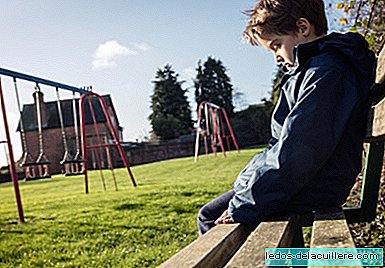
The ANAR Foundation has just published the data of its III Study on bullying and cyberbullying according to those affected, carried out together with the Mutua Madrileña Foundation, and based on the testimonies and feelings of the boys and girls who suffer bullying. The data remains alarming, although In 2017, the number of cases fell significantly with respect to the previous year, they have increased in frequency and severity.
Bullying is a very serious issue that requires everyone's involvement and collaboration to eradicate it. There is no need to look the other way, because for those who suffer, the consequences can be devastating, both physically and psychologically.
Less cases of bullying and greater awareness ...
The study throws two encouraging data:
On the one hand, a notable decrease in the number of cases registered in 2017 with respect to 2016. Specifically, 809 calls related to bullying, which resulted in 590 cases, were answered on ANAR's phone. These figures are far from those recorded in 2016, when 1,728 calls were counted resulting in 1,207 cases.
On the other hand, a greater social awareness has been appreciated, as well as a greater involvement of teachers and public administrations. This is due to the multiple informative and preventive campaigns that have been carried out for a long time, and that little by little have been entering the conscience of the citizens in general, and of the students in particular.
... but more frequent and serious episodes

However, and despite the fact that the number of cases seems to have decreased, a worrying upward trend in the severity of violence and the frequency of violence, which has led 13 percent of victims to have to change schools due to the harassment they suffered.
To assess the severity of the situation detected, the ANAR Foundation has objectively studied how the victim's life is modified or affected, as well as the emotional and physical damage he is suffering. And in this sense, it has been detected that 97 percent of victims of bullying suffer episodes of medium and high severity.
As for the type of aggressions, the verbal ones, the isolation to which the victim is subjected, and the slight physical aggressions (pushing, shaking ...) increased markedly in 2017 with respect to what was recorded in the previous year. And more or less the same number of cases of strong physical aggressions (kicks, punches ...), sexual, rumor spreading and theft or breakage of belongings continue.
With respect to the duration of bullying, more than 35 percent of victims state that episodes of violence have become more frequent, and in more than half of the cases the harassment lasts more than a year and has a daily frequency.
In addition, the cases in which harassment is practiced by virtually the entire class (14.4%) have been doubled, although in most cases (49.4%) violence is exercised between two and five people.One in four cases of harassment is cyberbullying
Cyberbullying accounts for almost 25 percent of total cases of bullying, with insults and threats being their most common form. The data obtained by ANAR reveal that sending WhatsApp through the mobile phone is the most common form of harassment.
The type profile of cyberbullying victim has not suffered great variations compared to other years, being the girls with an average age of 13.5 years who suffer most. On the other hand, bullying has a higher incidence among boys, and it usually occurs among students with an average age of 10 years.
The role of the environment
As we said at the beginning, the ANAR report shows that the victim's environment is increasingly aware of the reality he suffers, and with regard to the attitude that teachers take, the assessment is much more positive than in previous years.
Almost 85 percent of teachers know about bullying towards one of their students, and in 51 percent of cases react bluntly, talking with the stalker, contacting the families of the victim and the aggressor, or taking another series of punitive measures.
However, the study also warns of a worrying fact and that there is still a high number of children who suffer bullying or cyberbullying that does not tell their parents (31 percent), so it is essential to continue Working trust and communication with our children.
Bullying and cyberbullying is not a children's thing
 Children who suffer bullying have, among other symptoms: depression, anxiety, fear, isolation and poor school performance. It is also common to find feelings of anger, low self-esteem and sleep disorders.
Children who suffer bullying have, among other symptoms: depression, anxiety, fear, isolation and poor school performance. It is also common to find feelings of anger, low self-esteem and sleep disorders.It is believed that the support expressed to the victim and the forcefulness in the action against the aggressor may be behind the decrease in the incidence of self-harm and suicide attempts by the victim, although from the ANAR Foundation they emphasize that these figures are not for the significant moment, and continue to focus on the 94 percent of child victims of bullying who suffer psychological problems.
Since we have seen situations of harassment from an early age, it is important to act with forcefulness at the first start, because bullying and cyberbullying are not children. And although more and more families and schools are involved in prevention and early detection, the ANAR report shows that there's still a long way to go.
Parents also have a very important responsibility: to prevent bullying from continuing, educating our children in empathy, love and respect, and providing them with tools that allow them to avoid being victims of bullying.
For their part, from the ANAR Foundation they ask for our collaboration to request the Government and Public Administrations to urgently process a Comprehensive Law against Violence against Children and Adolescents that protects minors against all types of violence, including Bullying.
Photos | iStock












